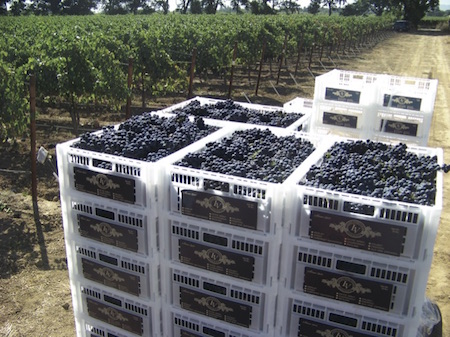Fresh Grape Packing Action for the Nation's Home Winemakers (Lodi Wine)

Every mid-September through early October, one of the common sights in vineyards in Lodi is pickers loading grapes into 40-pound lug boxes. Next to the vines, the pickers weigh each lug box on scales in order to be as precise as possible. At the edge of the vineyards, on the side of the road, the lugs are then emptied into colorful wooden boxes by grape packers.
Each crate — filled with grapes such as Cabernet Sauvignon, Merlot, Zinfandel, or Carignan — is sealed with a curved wooden top, and the boxes are bundled together with steel strapping on 36-box pallets, before being loaded onto trucks.
These loads of fresh grapes, packed in their colorful boxes right in the middle of the fields, are not destined for wineries. Instead, they are headed to retail markets in the Midwest, the East Coast as well as Canada, where they are sold to home winemakers who look forward each year to enjoying the experience of making wines for themselves.
It is not, as it were, difficult to produce wine. All you really need to do is “crush” the grapes — with your feet, your hands, a paddle, whatever is handy — to allow the sugary juice in each berry to come into contact with the natural yeasts found on the skins. When that happens, grapes ferment all by themselves.
The kits typically sold to home winemakers, however, usually contain packets of dried yeasts with instructions on their usage — the thinking being those amateur winemakers are less likely to be disappointed with the results if they rely on laboratory-created yeast rather than on unpredictable native (or “wild”) yeast strains.

